货币银行学 米什金 15章
- 格式:ppt
- 大小:495.00 KB
- 文档页数:25
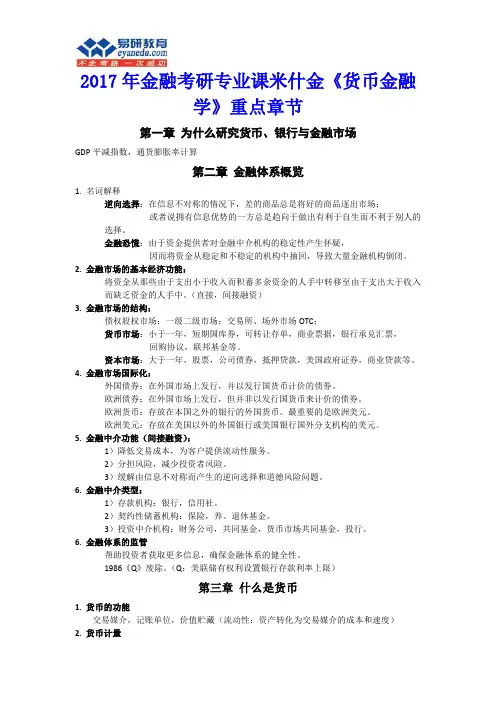
2017年金融考研专业课米什金《货币金融学》重点章节第一章为什么研究货币、银行与金融市场GDP平减指数,通货膨胀率计算第二章金融体系概览1.名词解释逆向选择:在信息不对称的情况下,差的商品总是将好的商品逐出市场;或者说拥有信息优势的一方总是趋向于做出有利于自生而不利于别人的选择。
金融恐慌:由于资金提供者对金融中介机构的稳定性产生怀疑,因而将资金从稳定和不稳定的机构中抽回,导致大量金融机构倒闭。
2.金融市场的基本经济功能:将资金从那些由于支出小于收入而积蓄多余资金的人手中转移至由于支出大于收入而缺乏资金的人手中。
(直接,间接融资)3.金融市场的结构:债权股权市场;一级二级市场;交易所、场外市场OTC;货币市场:小于一年,短期国库券,可转让存单,商业票据,银行承兑汇票,回购协议,联邦基金等。
资本市场:大于一年,股票,公司债券,抵押贷款,美国政府证券,商业贷款等。
4.金融市场国际化:外国债券:在外国市场上发行,并以发行国货币计价的债券。
欧洲债券:在外国市场上发行,但并非以发行国货币来计价的债券。
欧洲货币:存放在本国之外的银行的外国货币。
最重要的是欧洲美元。
欧洲美元:存放在美国以外的外国银行或美国银行国外分支机构的美元。
5.金融中介功能(间接融资):1)降低交易成本,为客户提供流动性服务。
2)分担风险,减少投资者风险。
3)缓解由信息不对称而产生的逆向选择和道德风险问题。
6.金融中介类型:1)存款机构:银行,信用社。
2)契约性储蓄机构:保险,养、退休基金。
3)投资中介机构:财务公司,共同基金,货币市场共同基金,投行。
6.金融体系的监管帮助投资者获取更多信息,确保金融体系的健全性。
1986《Q》废除。
(Q:美联储有权利设置银行存款利率上限)第三章什么是货币1.货币的功能交易媒介,记账单位,价值贮藏(流动性:资产转化为交易媒介的成本和速度)2.货币计量M1=通货+旅行者支票+活期存款+其他支票存款M2=M1+小额定期存款+储蓄存款与货币市场存款账户+货币市场共同基金份额第四章理解利率1.四种信用市场工具1)普通贷款:到期支付本金与利息,如商业贷款。

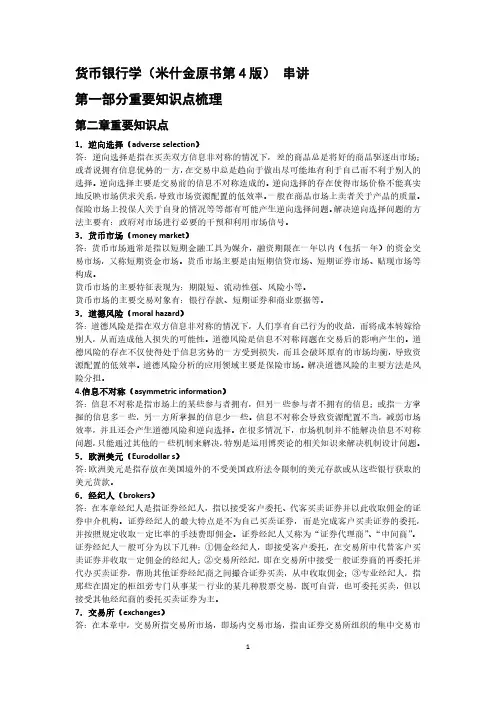
货币银行学(米什金原书第4版) 串讲第一部分重要知识点梳理第二章重要知识点1.逆向选择(adverse selection)答:逆向选择是指在买卖双方信息非对称的情况下,差的商品总是将好的商品驱逐出市场;或者说拥有信息优势的一方,在交易中总是趋向于做出尽可能地有利于自己而不利于别人的选择。
逆向选择主要是交易前的信息不对称造成的。
逆向选择的存在使得市场价格不能真实地反映市场供求关系,导致市场资源配置的低效率。
一般在商品市场上卖者关于产品的质量。
保险市场上投保人关于自身的情况等等都有可能产生逆向选择问题。
解决逆向选择问题的方法主要有:政府对市场进行必要的干预和利用市场信号。
3.货币市场(money market)答:货币市场通常是指以短期金融工具为媒介,融资期限在一年以内(包括一年)的资金交易市场,又称短期资金市场。
货币市场主要是由短期信贷市场、短期证券市场、贴现市场等构成。
货币市场的主要特征表现为:期限短、流动性强、风险小等。
货币市场的主要交易对象有:银行存款、短期证券和商业票据等。
3.道德风险(moral hazard)答:道德风险是指在双方信息非对称的情况下,人们享有自己行为的收益,而将成本转嫁给别人,从而造成他人损失的可能性。
道德风险是信息不对称问题在交易后的影响产生的。
道德风险的存在不仅使得处于信息劣势的一方受到损失,而且会破坏原有的市场均衡,导致资源配置的低效率。
道德风险分析的应用领域主要是保险市场。
解决道德风险的主要方法是风险分担。
4.信息不对称(asymmetric information)答:信息不对称是指市场上的某些参与者拥有,但另一些参与者不拥有的信息;或指一方掌握的信息多一些,另一方所掌握的信息少一些。
信息不对称会导致资源配置不当,减弱市场效率,并且还会产生道德风险和逆向选择。
在很多情况下,市场机制并不能解决信息不对称问题,只能通过其他的一些机制来解决,特别是运用博奕论的相关知识来解决机制设计问题。

Chapter1物价总水平资产预算赤字预算盈余经济周期资产转换逆向选择信息不对称道德风险货币市场场外市场商品货币通货流动性价值储藏记账单位交易媒介基点统一公债/永续债券指数化债券利率风险名义利率贴现发行债券(零息债券)到期收益率固定支付贷款不变价回报需求曲线预期回报率可贷资金可贷资金理论市场均衡流动性偏好理论供给曲线普通股财政政策外汇市场金融中介金融市场Chapter2股利一级市场风险分担交易成本承销Chapter3M1 M2M3恶性通货膨胀货币总量收入Chapter4普通贷款贴现收益率现期贴现值实际利率息票债券当期收益息票利率率现值资本利得率Chapter5资产需求理论机会成本风险超额需求超额供给费雪效应Chapter6无违约风险债券预期理论翻转的收益率曲线流动性溢价理论期限优先理论适应性预期现金流量股利有效市场假定随机游走戈登增长模型市场基本面代理理论银行业恐慌现金流量抵押品债务萎缩金融危机搭便车鼓励相容啄食顺序假定资产管理资产负债表资本充足性管理补偿余额信用配给信用风险存款外流贴现贷款贴现率久期分析股本乘数超额准备金缺口分析利率风险风险溢价利率的风险结构分割市场理论利率的期限结构收益率曲线Chapter7最优预测未被利用的盈利机会理性预期剩余索取权有效资本市场理论推广的股利估值模型Chapter8委托-代理理论限制性条款担保债务高额核实成本资不抵债净值无担保债务风险投资公司Chapter9负债管理流动性管理贷款承诺贷款出售表外业务法定准备金率法定准备金准备金资产回报率股权回报率二级准备金 T账户库存现金Chapter10自动银行机自动提款机存款利率上限脱媒银行破产银行监管巴塞尔协议商誉年金封闭式基金共同保险免赔额固定受益型计划固定缴费型计划足额基金对冲基金美式期权套利买入期权货币互换欧式期权执行价格衍生金融工具金融期货合约金融期货期权远期合约避险远期利率合约利率互换公开市场操作目标独立性贴现率金融衍生工具期货合约证券化Chapter11杠杆比率表外业务监管套利监管宽容Chapter12初次公开发行(IPO)付佣基金非付佣基金开放式基金再保险适时发行不足额基金承销商Chapter13长头寸综合避险保证金盯市单个避险名义本金未平仓合约期权期权费卖出期权短头寸股票期权互换Chapter14工具独立性Chapter15超额准备金浮款高能货币基础货币多倍存款创造公开市场操作公开市场购买货币乘数防御性市场操作贴现窗口能动性公开市场操作联邦基金率工具指标中介指标国际政策协调自然失业率非加速型通货膨胀失业率升值资本流动性贬值有效汇率指数配额现汇率汇率汇率超调外汇市场国际收支平衡表资本账户固定汇率制度国际货币基金组织官方储备交易余额特别提款权非冲销性外汇干预国际收支危机经常账户公开市场出售法定准备金率法定准备金准备金简单存款乘数Chapter16非借入基础货币Chapter17最后贷款人再买回交易(反回购协议)一级交易商回购协议Chapter18操作指标菲利普斯曲线真实票据原则泰勒规则Chapter19远期汇率现汇交易关税远期交易利息平价条件一价定律货币中性购买力平价理论Chapter20外汇干预国际储备储备货币冲销性外汇干预世界银行布雷顿森林体系法定贬值金本位制度有管理的浮动制度法定升值货币局美元化铸币税交易方程式货币理论实际货币余额总需求总需求函数浮躁情绪自主性消费支出净出口存货投资消费函数可支配收入总需求曲线长期货币中性积极干预主义者总需求总需求曲线总供给总供给曲线浮躁情绪自我纠错机制供给冲击货币流通速度后遗效应凯恩斯主义者长期总供给曲线现代货币数量论耐用消费品支出贸易余额Chapter21名义锚时间一致性问题Chapter22流动性偏好理论货币数量论货币流通速度Chapter23支出乘数固定投资消费支出计划投资支出 LS曲线 LM曲线边际消费倾向政府支出Chapter24总产出的自然水平完全挤出Chapter25货币主义者完全挤出效应消费支出交易方程式政府支出非加速通货膨胀型失业率非积极干预主义者部分挤出效应计划投资支出真是经济周期理论总产出的自然率水平净出口Chapter26消费信用途径消费简化形式实证分析适应性政策单一货币增长规则成本推进型通货膨胀需求拉动型通货膨胀计量经济模型政策无效命题结构模型实证分析货币政策传导机制 Chapter27 政府预算约束债务货币化李嘉图平衡式政府印钞 Chapter28。
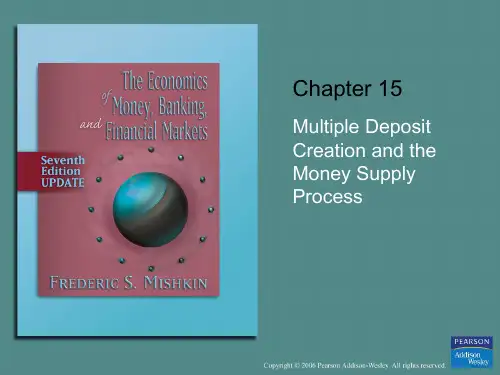

货币银行学笔记2.0【米什金笔记】序:货币银行学笔记1.0指的是本座在12年后编写的【胡庆康笔记】,由于缺少了货币理论的三个章节,所以该笔记是一部残篇。
为了能够更好的解释货币银行学,故引用米什金第九版货币金融学作为蓝本进行笔记升级。
笔记主体将由米什金组成,由黄达胡庆康等作品为辅助。
这本笔记的编撰主要是服务于本座的学习实践,所以有的本座认为不必赘述的就略过,不必证明的就直接给结论。
在阅读顺序上,建议读者先阅读笔者的《胡庆康笔记》,后阅读笔者的《米什金笔记》。
章节编写上,由【大纲】/导图,【内容】/主干知识,【补充】/边角知识,【关键术语】,【习题】,【胡说】/编者说(红字) 组成。
其中【胡说】均标红色,仅代表编者看法。
在写作上,笔记多表格少文字,多截图少写字。
表格看的更舒服,截图表示有根据。
【画外音:本座懒】本笔记撰写者:西班牙溃疡/西班牙流感/履虎尾。
天下学问,惟夜航船中最难对付。
2016年7月2日星期六福州 五四路第零章:大纲 我们将针对以下章节展开描述:第1篇 引言第1章 为什么研究货币、银行与金融市场第2章 金融体系概览第3章 什么是货币?第2篇 金融市场第4章 理解利率第5章 利率行为第6章 利率的风险结构与期限结构第7章 股票市场、理性预期理论与有效市场假定 第3篇 金融机构【略】第8章 金融结构的经济学分析第9章 金融危机与次贷风波第10章 银行业与金融机构的管理第11章 金融监管的经济学分析第12章 银行业:结构与竞争第4篇 中央银行与货币政策运作第13章 中央银行的结构与联邦储备体系【略】第14章 多倍存款创造和货币供给过程第15章 货币政策工具第16章 货币政策的操作:战略与战术第5篇 国际金融与货币政策第17章 外汇市场第18章 国际金融体系第19章 货币需求第20章 is-lm模型第21章 is—lm模型中的货币政策与财政政策第22章 总需求与总供给分析第23章 货币政策传导机制的实证分析第24章 货币与通货膨胀第25章 理性预期:政策意义第一章:为什么研究货币、银行与金融市场【胡说】要回答这个问题,首先要回答四个what和一个how1、为什么研究金融市场?2、为什么研究银行和其他金融机构?3、为什么研究货币和货币政策?4、为什么研究国际金融?5、我们如何研究货币、银行与金融市场?简单的说,为什么要研究市场,为什么要研究机构,为什么要研究政策,为什么要研究国际环境。
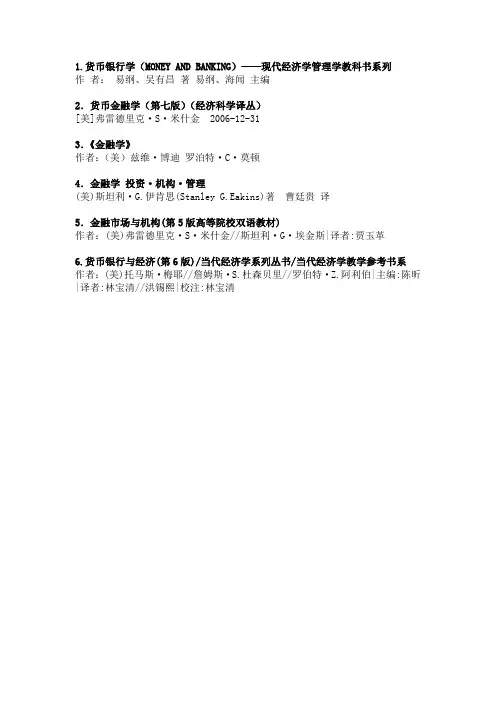
1.货币银行学(MONEY AND BANKING)——现代经济学管理学教科书系列作者:易纲、吴有昌著易纲、海闻主编2.货币金融学(第七版)(经济科学译丛)[美]弗雷德里克·S·米什金 2006-12-313.《金融学》作者:(美)兹维·博迪罗泊特·C·莫顿4.金融学投资·机构·管理(美)斯坦利·G.伊肯思(Stanley G.Eakins)著曹廷贵译5.金融市场与机构(第5版高等院校双语教材)作者:(美)弗雷德里克·S·米什金//斯坦利·G·埃金斯|译者:贾玉革6.货币银行与经济(第6版)/当代经济学系列丛书/当代经济学教学参考书系作者:(美)托马斯·梅耶//詹姆斯·S.杜森贝里//罗伯特·Z.阿利伯|主编:陈昕|译者:林宝清//洪锡熙|校注:林宝清书籍内容简介1.货币银行学(MONEY AND BANKING)——现代经济学管理学教科书系列作者:易纲、吴有昌著易纲、海闻主编出版社:上海人民出版社ISBN: 7208032750出版时间: 1999-9第1版书籍介绍:本书试图将现代货币银行理论与中国的具体实践有机地融合起来,从而形成一个既反映现代货币银行理论的优秀成果,又具有中国特色的货币银行学体系。
针对国内同类教科书大多只编重制度性和操作性方面内容的特点,我们试图在理论性内容方面有所加强。
本书结合课程内容设计了28个专栏,这些专栏有助于增强学生对所学内容的感性认识,培养学生关注现实问题的兴趣。
由于篇幅所限,同时也考虑到绝大多数高校的经济类院系都开设了专门的国际金融课程。
本书是“现代经济学管理学教科书系列”之一。
该教科书系列的主编易纲先生在编著本书时,力求了联系世界经济和中国经济的实际,在充分体现理论深度的同时注重教材的实用性。
本书共分6篇;基本概念;金融机构与金融市场;货币供求及利率决定;货币与经济;金融与经济发展;货币政策。
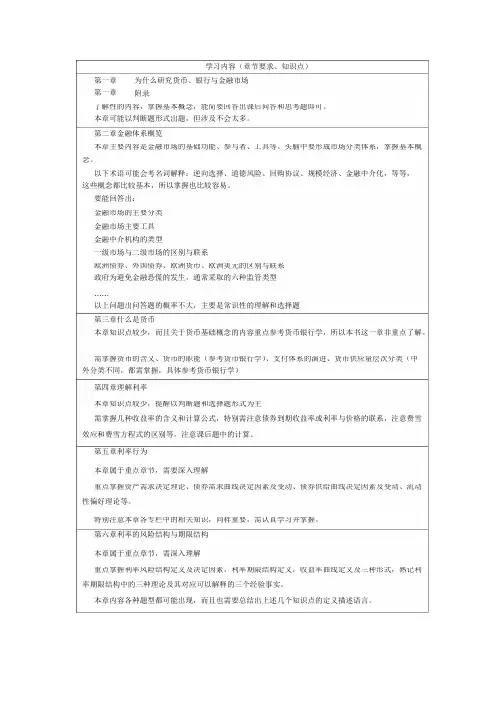
学习内容(章节要求、知识点)第一章第一章为什么研究货币、银行与金融市场附录了解性的内容,掌握基本概念,能简要回答出课后问答和思考题即可。
本章可能以判断题形式出题,但涉及不会太多。
第二章金融体系概览本章主要内容是金融市场的基础功能、参与者、工具等。
头脑中要形成市场分类体系,掌握基本概念。
以下术语可能会考名词解释:逆向选择、道德风险、回购协议、规模经济、金融中介化,等等,这些概念都比较基本,所以掌握也比较容易。
要能回答出:金融市场的主要分类金融市场主要工具金融中介机构的类型一级市场与二级市场的区别与联系欧洲债券、外国债券、欧洲货币、欧洲美元的区别与联系政府为避免金融恐慌的发生,通常采取的六种监管类型……以上问题出问答题的概率不大,主要是常识性的理解和选择题第三章什么是货币本章知识点较少,而且关于货币基础概念的内容重点参考货币银行学,所以本书这一章非重点了解。
需掌握货币的含义、货币的职能(参考货币银行学)、支付体系的演进、货币供应量层次分类(中外分类不同,都需掌握,具体参考货币银行学)第四章理解利率本章知识点较少,提醒以判断题和选择题形式为主需掌握几种收益率的含义和计算公式,特别需注意债券到期收益率或利率与价格的联系,注意费雪效应和费雪方程式的区别等。
注意课后题中的计算。
第五章利率行为本章属于重点章节,需要深入理解重点掌握资产需求决定理论、债券需求曲线决定因素及变动、债券供给曲线决定因素及变动、流动性偏好理论等。
特别注意本章各专栏中的相关知识,同样重要,需认真学习并掌握。
第六章利率的风险结构与期限结构本章属于重点章节,需深入理解重点掌握利率风险结构定义及决定因素,利率期限结构定义,收益率曲线定义及三种形式,熟记利率期限结构中的三种理论及其对应可以解释的三个经验事实。
本章内容各种题型都可能出现,而且也需要总结出上述几个知识点的定义描述语言。
第七章股票市场、理性预期理论与有效市场假定本章内容涉及知识点并不在本书中,主要需在公司理财课本中掌握知识点如下:适应性预期、套利的定义、戈登增长模型、最优预测、随机游走的定义、有效市场的假定和三种形式市场分类以及市场异象举例。
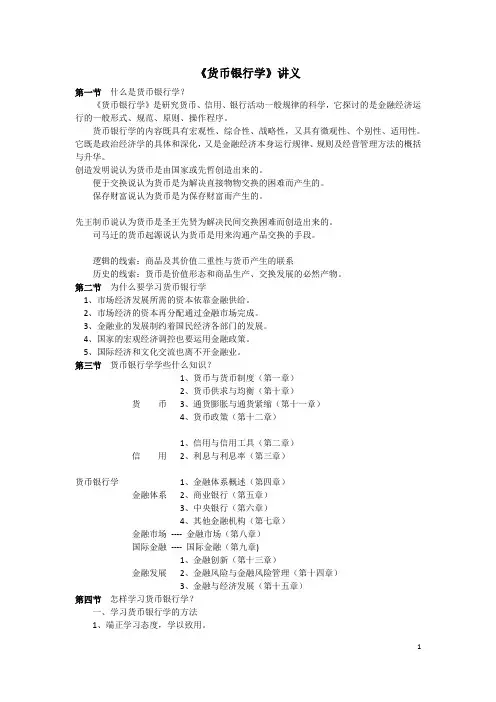
《货币银行学》讲义第一节什么是货币银行学?《货币银行学》是研究货币、信用、银行活动一般规律的科学,它探讨的是金融经济运行的一般形式、规范、原则、操作程序。
货币银行学的内容既具有宏观性、综合性、战略性,又具有微观性、个别性、适用性。
它既是政治经济学的具体和深化,又是金融经济本身运行规律、规则及经营管理方法的概括与升华。
创造发明说认为货币是由国家或先哲创造出来的。
便于交换说认为货币是为解决直接物物交换的困难而产生的。
保存财富说认为货币是为保存财富而产生的。
先王制币说认为货币是圣王先贤为解决民间交换困难而创造出来的。
司马迁的货币起源说认为货币是用来沟通产品交换的手段。
逻辑的线索:商品及其价值二重性与货币产生的联系历史的线索:货币是价值形态和商品生产、交换发展的必然产物。
第二节为什么要学习货币银行学1、市场经济发展所需的资本依靠金融供给。
2、市场经济的资本再分配通过金融市场完成。
3、金融业的发展制约着国民经济各部门的发展。
4、国家的宏观经济调控也要运用金融政策。
5、国际经济和文化交流也离不开金融业。
第三节货币银行学学些什么知识?1、货币与货币制度(第一章)2、货币供求与均衡(第十章)货币3、通货膨胀与通货紧缩(第十一章)4、货币政策(第十二章)1、信用与信用工具(第二章)信用2、利息与利息率(第三章)货币银行学1、金融体系概述(第四章)金融体系2、商业银行(第五章)3、中央银行(第六章)4、其他金融机构(第七章)金融市场---- 金融市场(第八章)国际金融---- 国际金融(第九章)1、金融创新(第十三章)金融发展2、金融风险与金融风险管理(第十四章)3、金融与经济发展(第十五章)第四节怎样学习货币银行学?一、学习货币银行学的方法1、端正学习态度,学以致用。
2、掌握货币银行学的基本概念、基本原理和基本理论。
3、充分吸取古今中外管理学理论精华,吸取精华,弃去糟粕。
4、在处理中国传统文化与西方管理理论时,既不固步自封,夜郎自大;也不崇洋媚外、全盘西化。

货币金融学第一章为什么研究货币、银行和金融市场?金融市场债券市场股票市场外汇市场……………..证券(security)又称金融工具,是对发行人未来收入与资产的的索取权。
债券是债务证券,承诺在特定的时间段的定期支付,是决定利率的场所,所以利率决定理论,无论是债券需求理论还是流动性偏好理论,都是将债券作为利率的传导机制。
股票,代表的是所有权,是对公司收益和资产的索取权。
金融市场中,资金从拥有闲置货币的人手中转移到资金短缺的人手中,债券市场和股票市场等金融市场将资金从没有生产用途的人转向有生产用途的人手中。
经济周期的误解,经济周期是不规则的,无法预测的,时间跨度变幻不定的,因为有时候经济周期也被称为经济波动。
金融机构银行保险公司共同基金其他金融机构货币经济周期(货币的供给变动是经济周期波动的推动力之一)通货膨胀(货币的持续增加是无价水平持续上涨的一个重要原因)利率货币政策国际金融外汇市场第二章金融体系概览金融市场的功能金融市场最基本的功能就是实现资金盈余者和资金短缺者之间的资金转移,通过直接融资(借款人直接发行债券)或者间接融资,完成了资本的合理配置(包括生产性用途或者物质消费)金融市场的结构债务市场和股权市场一级市场和二级市场交易所和场外市场货币市场和资本市场金融市场工具货币市场工具美国国库券可转让存单商业票据回购协议联邦基金(容易困惑,不是联邦,而是银行间的贷款)资本市场工具股票抵押贷款企业债券美国政府债券美国政府机构债券州和地方政府债券消费者贷款和商业银行贷款金融中介机构的功能为什么金融中介结构和间接融资对金融市场而言如此重要?交易成本(金融中介具有降低成本的专门技术和规模经济)风险分担(资产转换和资产组合多样化)信息不对称造成的逆向选择和道德风险(甄别信贷风险技术和监督)而金融机构为经济社会提供了流动性服务,承担风险分担职能,并解决信息问题,金融中介机构的类型存款机构商业银行储蓄和贷款协会和互助储蓄银行信用社契约性储蓄机构保险公司和养老基金人寿保险公司火灾和意外伤害保险公司养老基金和政府退休基金投资中介机构财务公司共同基金货币市场共同基金投资银行金融体系的监管金融体系受到最严格的监管,旨在帮助投资者获得更多的信息和确保金融体系的健全性。
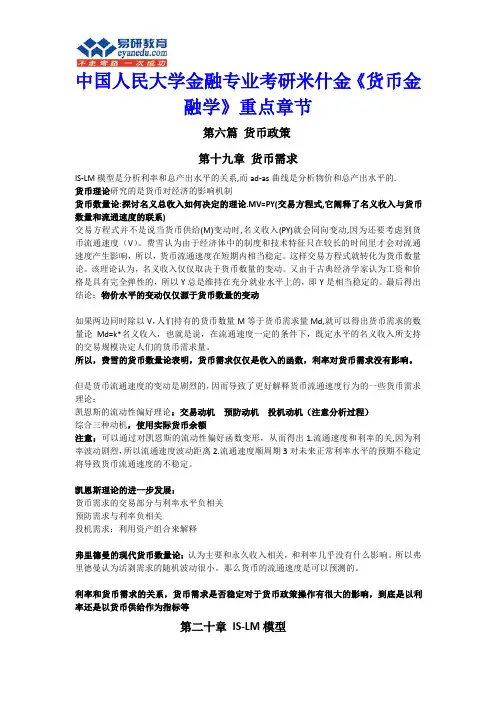
中国人民大学金融专业考研米什金《货币金融学》重点章节第六篇货币政策第十九章货币需求IS-LM模型是分析利率和总产出水平的关系,而ad-as曲线是分析物价和总产出水平的.货币理论研究的是货币对经济的影响机制货币数量论:探讨名义总收入如何决定的理论.MV=PY(交易方程式,它阐释了名义收入与货币数量和流通速度的联系)交易方程式并不是说当货币供给(M)变动时,名义收入(PY)就会同向变动,因为还要考虑到货币流通速度(V)。
费雪认为由于经济体中的制度和技术特征只在较长的时间里才会对流通速度产生影响,所以,货币流通速度在短期内相当稳定。
这样交易方程式就转化为货币数量论。
该理论认为,名义收入仅仅取决于货币数量的变动。
又由于古典经济学家认为工资和价格是具有完全弹性的,所以Y总是维持在充分就业水平上的,即Y是相当稳定的。
最后得出结论:物价水平的变动仅仅源于货币数量的变动如果两边同时除以V,人们持有的货币数量M等于货币需求量Md,就可以得出货币需求的数量论Md=k*名义收入,也就是说,在流通速度一定的条件下,既定水平的名义收入所支持的交易规模决定人们的货币需求量。
所以,费雪的货币数量论表明,货币需求仅仅是收入的函数,利率对货币需求没有影响。
但是货币流通速度的变动是剧烈的,因而导致了更好解释货币流通速度行为的一些货币需求理论:凯恩斯的流动性偏好理论:交易动机预防动机投机动机(注意分析过程)综合三种动机,使用实际货币余额注意:可以通过对凯恩斯的流动性偏好函数变形,从而得出1.流通速度和利率的关,因为利率波动剧烈,所以流通速度波动距离2.流通速度顺周期3对未来正常利率水平的预期不稳定将导致货币流通速度的不稳定。
凯恩斯理论的进一步发展:货币需求的交易部分与利率水平负相关预防需求与利率负相关投机需求:利用资产组合来解释弗里德曼的现代货币数量论:认为主要和永久收入相关,和利率几乎没有什么影响。
所以弗里德曼认为活剥需求的随机波动很小。
货币金融学第一章为什么研究货币、银行和金融市场?金融市场债券市场股票市场外汇市场……………..证券(security)又称金融工具,是对发行人未来收入与资产的的索取权。
债券是债务证券,承诺在特定的时间段的定期支付,是决定利率的场所,所以利率决定理论,无论是债券需求理论还是流动性偏好理论,都是将债券作为利率的传导机制。
股票,代表的是所有权,是对公司收益和资产的索取权。
金融市场中,资金从拥有闲置货币的人手中转移到资金短缺的人手中,债券市场和股票市场等金融市场将资金从没有生产用途的人转向有生产用途的人手中。
经济周期的误解,经济周期是不规则的,无法预测的,时间跨度变幻不定的,因为有时候经济周期也被称为经济波动。
金融机构银行保险公司共同基金其他金融机构货币经济周期(货币的供给变动是经济周期波动的推动力之一)通货膨胀(货币的持续增加是无价水平持续上涨的一个重要原因)利率货币政策国际金融外汇市场第二章金融体系概览金融市场的功能金融市场最基本的功能就是实现资金盈余者和资金短缺者之间的资金转移,通过直接融资(借款人直接发行债券)或者间接融资,完成了资本的合理配置(包括生产性用途或者物质消费)金融市场的结构债务市场和股权市场一级市场和二级市场交易所和场外市场货币市场和资本市场金融市场工具货币市场工具美国国库券可转让存单商业票据回购协议联邦基金(容易困惑,不是联邦,而是银行间的贷款)资本市场工具股票抵押贷款企业债券美国政府债券美国政府机构债券州和地方政府债券消费者贷款和商业银行贷款金融中介机构的功能为什么金融中介结构和间接融资对金融市场而言如此重要?交易成本(金融中介具有降低成本的专门技术和规模经济)风险分担(资产转换和资产组合多样化)信息不对称造成的逆向选择和道德风险(甄别信贷风险技术和监督)而金融机构为经济社会提供了流动性服务,承担风险分担职能,并解决信息问题,金融中介机构的类型存款机构商业银行储蓄和贷款协会和互助储蓄银行信用社契约性储蓄机构保险公司和养老基金人寿保险公司火灾和意外伤害保险公司养老基金和政府退休基金投资中介机构财务公司共同基金货币市场共同基金投资银行金融体系的监管金融体系受到最严格的监管,旨在帮助投资者获得更多的信息和确保金融体系的健全性。
考试题型以及分数分布:一、选择题:1’*20=20’二、名词解释:4’*5=20’三、简答题:8’*5=40’四、论述题:20’*1=20’重点制作思路:1.考虑到时间关系,抓大放小2.结合老师提及复习内容进行预测3.以理顺书本架构为主,看到一个知识点猜一下可能会出什么题The economics of money,banking and financial markets----by Kyle Chapter1:Why Study Money, Banking, and Financial Markets?(本章了解一下这个问题即可,最多考一下选择)Answer:•To examine how financial markets such as bond and stock markets work •To examine how financial institutions such as banks work•To examine the role of money in the economyChapter2:An Overview of the Financial System1. Function of Financial Markets•Perform the essential function of channeling funds from economic players that have saved surplus funds to those that have a shortage of funds •Direct finance: borrowers borrow funds directly from lenders in financial markets by selling them securities.•Promotes economic efficiency by producing an efficient allocation(分配)of capital(资金), which increases production•Directly improve the well-being of consumers by allowing them to time purchases better2.Structure of Financial Markets•Debt and Equity (普通股) Markets•Primary and Secondary Markets•Exchanges and Over-the-Counter (OTC不通过交易所而直接售给顾客的) Markets •Money and Capital Markets(货币和资本市场)3. Financial Market Instruments(要能举出例子,很可能考选择)Money markets deal in short-term debt instrumentsCapital markets deal in longer-term debt and equity instruments.4.Internationalization of Financial Markets(重点,选择、名词解释都有可能)•Foreign Bonds & Eurobond?•Eurocurrencies & Eurodollars?•World Stock Markets5.Function of Financial Intermediaries: Indirect Finance(记一下金融中介机构的功能,交易成本很可能考名词解释)•Lower transaction costs (time and money spent in carrying out financial transactions).•Reduce the exposure of investors to risk•Deal with asymmetric 不对称 information problems•Conclusion:Financial intermediaries allow “small” savers and borrowers to benefit from the existence of financial markets.6. Types of Financial Intermediaries(会分类即可)Depository institutionsContractual saving institutionsInvestment intermediaries7. Regulation of the Financial System•To increase the information available to investors:•To ensure the soundness 健康稳固of financial intermediariesChapter3:What Is Money?1. Meaning of Money(即definition,必考名词解释!!)•Money (or the “money supply”): anything that is generally accepted in payment for goods or services or in the repayment of debts.2. Functions of Money(重点)•Medium of Exchange:• A medium of exchange must•Unit of Account:•Store 储藏 of Value:3. Evolution of the Payments System•Commodity 商品 Money•Fiat 法定 Money•Checks 支票Electronic Payment (e.g. online bill pay).•E-Money (electronic money):4. Measuring Money (重中之重,M1/M2都很有可能考名词解释)•Construct monetary aggregates using the concept of liquidity: (构建货币总量使用流动性的概念)•M1 (most liquid assets)= currency + traveler’s checks + demand deposits + other checkable deposits.•M2 (adds to M1 other assets that are not so liquid)= M1 + small denomination time deposits + savings deposits and money market deposit accounts + money market mutual fund shares.Chapter 4:Understanding Interest Rates1.measuring interest rates:Present Value(很可能考察名词解释)A dollar paid to you one year from now is less valuable than a dollar paidto you todaySimple Present Value:PV=CF/(1+i)n次方2.Four Types of Credit Market Instruments•Simple Loan•Fixed Payment Loan•Coupon Bond 附票债券•Discount Bond 贴现债券3.Yield to Maturity(重点,很可能名词解释)•The interest rate that equates the present value of cash flow payments received from a debt instrument with its value today计算4种不同信用工具外加Consol or Perpetuity(金边债券或永久债券)的YM4. Yield on a Discount Basis(了解即可)Current Yield当期收益率Yield on a Discount Basis 折价收益率Rate of Return 收益率5.Rate of Return and Interest Rates(收益率与利息率的distinction)•The return equals the yield to maturity only if the holding period equals the time to maturity• A rise in interest rates is associated with a fall in bond prices, resulting in a capital loss if time to maturity is longer than the holding period •The more distant a bond’s maturity, the gr eater the size of the percentage price change associated with an interest-rate change•The more distant a bond’s maturity, the lower the rate of return the occurs as a result of an increase in the interest rate•Even if a bond has a substantial initial interest rate, its return can be negative if interest rates rise6. Interest-Rate Risk•Prices and returns for long-term bonds are more volatile than those for shorter-term bonds•There is no interest-rate risk for any bond whose time to maturity matches the holding period7. Real and Nominal Interest Rates(重点,很可能考察简答题)•Nominal interest rate makes no allowance for inflation•Real interest rate is adjusted for changes in price level so it more accurately reflects the cost of borrowing•Ex ante real interest rate is adjusted for expected changes in the price level•Ex post real interest rate is adjusted for actual changes in the price level8. Fisher Equation(重点考察)Chapter5:The Behavior of Interest Rates1. Determining the Quantity Demanded of an Asset•Wealth: the total resources owned by the individual, including all assets •Expected Return: the return expected over the next period on one asset relative to alternative assets•Risk: the degree of uncertainty associated with the return on one asset relative to alternative assets•Liquidity: the ease and speed with which an asset can be turned into cash relative to alternative assets(流动性很有可能考名词解释)2.Theory of Asset Demand(必考,死活都得背下来)Holding all other factors constant:1.The quantity demanded of an asset is positively related to wealth2.The quantity demanded of an asset is positively related to its expectedreturn relative to alternative assets3.The quantity demanded of an asset is negatively related to the riskof its returns relative to alternative assets4.The quantity demanded of an asset is positively related to itsliquidity relative to alternative assets3. Supply and Demand for Bonds(见到看一下图)Market Equilibrium4. Shifts in the Demand for Bonds•Wealth: in an expansion with growing wealth, the demand curve for bonds shifts to the right•Expected Returns: higher expected interest rates in the future lower the expected return for long-term bonds, shifting the demand curve to the left •Expected Inflation: an increase in the expected rate of inflations lowers the expected return for bonds, causing the demand curve to shift to the left •Risk: an increase in the riskiness of bonds causes the demand curve to shift to the left•Liquidity: increased liquidity of bonds results in the demand curve shifting right5.Shifts in the Supply of Bonds•Expected profitability of investment opportunities: in an expansion, the supply curve shifts to the right•Expected inflation: an increase in expected inflation shifts the supply curve for bonds to the right•Government budget: increased budget deficits shift the supply curve to the right6. The Liquidity Preference Framework(重中之重)7.Demand for Money in the Liquidity Preference Framework•As the interest rate increases:–The opportunity cost of holding money increases…–The relative expected return of money decreases…•…and therefore the quantity demanded of money decreases.8.Shifts in the Demand for Money(都很重要)•Income Effect: a higher level of income causes the demand for money at each interest rate to increase and the demand curve to shift to the right •Price-Level Effect: a rise in the price level causes the demand for money at each interest rate to increase and the demand curve to shift to the right•Liquidity preference framework leads to the conclusion that an increase in the money supply will lower interest rates: the liquidity effect.•Income effect finds interest rates rising because increasing the money supply is an expansionary influence on the economy (the demand curve shifts to the right).Chapter9:Banking1.The Bank Balance Sheet•Liabilities–Checkable deposits–Nontransaction deposits–Borrowings–Bank capital•Assets–Reserves(准备金)–Cash items in process of collection–Deposits at other banks–Securities–Loans–Other assets2.Basic Banking:•Cash Deposit:Opening of a checking account leads to an increase in the bank’s reserves equal to the increase in checkable depositsCheck Deposit3.Inter-business•Bank settlement•Finance lease•Fiduciary business•Safe deposit box4. Off-Balance-Sheet Activities•Loan sales (secondary loan participation)•Generation of fee income. Examples:Chapter12:Central Banks and the Federal Reserve System(此章省略很多)1.Structure of theFed(了解即可)Board of Governors(7人)12 FRBs(9人)FOMC (7+1+4人)Federal Advisory Council (12人)2.Federal Reserve Bank(3+3+3人)Functions:Clear checksIssue new currencyWithdraw damaged currency from circulationAdminister and make discount loans to banks in their districtsEvaluate proposed mergers and applications for banks to expand their activities Act as liaisons between the business community and the Federal Reserve System Examine bank holding companies and state-chartered member banksCollect data on local business conditionsUse staffs of professional economists to research topics related to the conduct of monetary policyChapter13&14:The Money Supply Process:1.Players in the Money Supply Process Central bank (Federal Reserve System)Banks (depository institutions; financial intermediaries)Depositors (individuals and institutions)2.Fed’s Balance Sheet3.Monetary Base4.Open Market Purchase•The effect of an open market purchase on reserves depends on whether the seller of the bonds keeps the proceeds from the sale in currency or in deposits •The effect of an open market purchase on the monetary base always increases the monetary base by the amount of the purchaseOpen Market Sale•Reduces the monetary base by the amount of the sale•Reserves remain unchangedThe effect of open market operations on the monetary base is much more certain than the effect on reserves5.Fed’s Ability to Control the MonetaryBaseSplit the monetary base into two components :MBn= MB - BRthe non-borrowed monetary base :MBnborrowed reserves:BR6.The Formula for Multiple Deposit Creation(很重要!必考,记住公式)7. Factors that Determine the Money SupplyChanges in the nonborrowed monetary base MBnChanges in borrowed reserves from the FedChanges in the required reserves ratioChanges in currency holdingsChanges in excess reserves8. The Money Multiplier(重点)Assume that the desired holdings of currency C and excess reserves ER grow proportionally with checkable deposits D. Then,c = {C/D} = currency ratioe = {ER/D} = excess reserves ratioThe monetary base MB equals currency (C) plus reserves (R):MB = C + R = C + (r x D) + ERM=m*MB=m*(MBn+BR)M=1+c/r+e+cChapter 15:Tools of Monetary Policy1. Tools of Monetary PolicyOpen market operationsChanges in borrowed reservesChanges in reserve requirementsFederal funds rate: the interest rate on overnight loans of reserves from one bank to another2.Demand in the Market for ReservesSupply in the Market for Reserves3.Affecting the Federal Funds Rate4.Open Market Operations(超级重点)Advantages:The Fed has complete control over the volumeFlexible and preciseEasily reversedQuickly implemented5.Discount Policy(超级重点)Advantages:Used to perform role of lender of last resortdisadvantages:Cannot be controlled by the Fed; the decision maker is the bank 6.Reserve Requirements(超级重点)Advantages:•No longer binding for most banksdisadvantages:•Can cause liquidity problems•Increases uncertainty for banks7. Monetary Policy Tools of the European Central Bank•Open market operations•Lending to banks•Reserve RequirementsChapter16:The Conduct of Monetary Policy: Strategy and Tactics 1. Goals of Monetary Policy(1)The Price Stability Goal•Low and stable inflation•Inflation•Nominal anchor to contain inflation expectations•Time-inconsistency problem(2)Other Goals of Monetary Policy•High employment•Economic growth•Stability of financial markets•Interest-rate stability•Foreign exchange market stability2. Monetary Targeting•Advantages–Almost immediate signals help fix inflation expectations and produce less inflation–Almost immediate accountability•Disadvantages–Must be a strong and reliable relationship between the goal variable and the targeted monetary aggregat e3. Inflation Targeting•Public announcement of medium-term numerical target for inflation •Institutional commitment to price stability as the primary, long-run goal of monetary policy and a commitment to achieve the inflation goal •Information-inclusive approach in which many variables are used in making decisions•Advantages•Does not rely on one variable to achieve target•Easily understood•Reduces potential of falling in time-inconsistency trap•Stresses transparency and accountability•Disadvantages•Delayed signaling•Too much rigidity•Potential for increased output fluctuations•Low economic growth during disinflation4.Monetary Policy with an Implicit Nominal AnchorThere is no explicit nominal anchor in the form of an overriding concern for the Fed.Forward looking behavior and periodic “preemptive strikes”The goal is to prevent inflation from getting started.•Advantages–Uses many sources of information–Avoids time-inconsistency problem•Disadvantages–Lack of transparency and accountability–Strong dependence on the preferences, skills, and trustworthiness of individuals in charge–Inconsistent with democratic principles5. Tactics: Choosing the Policy Instrument•Tools–Open market operation–Reserve requirements–Discount rate•Policy instrument (operating instrument)–Reserve aggregates–Interest rates–May be linked to an intermediate target•Interest-rate and aggregate targets are incompatible (must chose one or the other).6.Linkages Between Central Bank Tools, Policy Instruments, Intermediate Targets, and Goals of Monetary Policy(中间目标是超级重点,死活都要背下来)Chapter19:The Demand for Money1.Velocity of Money and The Equation ofExchangeV=P*Y/MM*V=P*Y2.Quantity Theory of Money DemandSO: Demand for money is determined by:The level of transactions generated by the level of nominal income PYThe institutions in the economy that affect the way people conduct transactions and thus determine velocity and hence k3.Keynes’s Liquidity Prefe rence TheoryTransactions motivePrecautionary motiveSpeculative motiveVelocity is not constant:4.Friedman’s Modern Quantity Theory of Money(记住该公式及其含义)5. Differences between Keynes’s and Friedman’s Model (cont’d)•Friedman–Includes alternative assets to money–Viewed money and goods as substitutes–The expected return on money is not constant; however, r b –r m does stayconstant as interest rates rise–Interest rates have little effect on the demand for money •Friedman (cont’d)–The demand for money is stable ?–velocity is predictable–Money is the primary determinant of aggregate spendingChapter23:Transmission Mechanisms of Monetary Policy: The Evidence1.Framework(1)Structural Modelwhether one variable affects another•Transmission mechanism–The change in the money supply affects interest rates–Interest rates affect investment spending–Investment spending is a component of aggregate spending (output) Advantages and Disadvantages(2)Reduced-Form•Analyzes the effect of changes in money supply on aggregate output (spending) to see if there is a high correlationAdvantages and Disadvantages2.Transmission Mechanisms of Monetary Policy(1) Asset Price EffectsTraditional interest rate effectsExchange rate effects on net exports...(2)Credit ViewChapter24:Money and Inflation1.meaning of inflation(死活背下来)extremely high for a sustained period of time, its rate of money supply growth is also extremely high•Money Growth–High money growth produces high inflation•Fiscal Policy–Persistent high inflation cannot be driven by fiscal policy alone •Supply Shocks–Supply-side phenomena cannot be the source of persistent high inflation•Conclusion: always a monetary phenomenon2. Origins of Inflationary Monetary Policy•Cost-push inflation–Cannot occur without monetary authorities pursuing an accommodating policy•Demand-pull inflation•Budget deficits–Can be the source only if the deficit is persistent and is financed by creating money rather than by issuing bonds•Two underlying reasons–Adherence of policymakers to a high employment target–Presence of persistent government budget deficits3. The Discretionary (Activist)/ Nondiscretionary (Nonactivist) Policy Debate(1)Advocates of discretionary policy:regard the self-correcting mechanism as slowPolicy lags slow activist policy(2)Advocates of nondiscretionary policy:believe government should not get involvedDiscretionary policy produces volatility in both the price level and output。